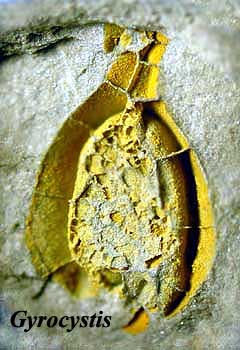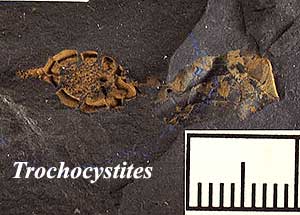
| Palaeos |  |
Homalozoa |
| Deuterostomia | Cincta |
| Page Back | Unit Back | Metazoa | Metazoa References | Metazoa Dendrogram | Pieces | Taxon Index |
| Page Next | Unit Next | Unit Home | Unit References | Unit Dendrogram | Glossary | Time |
Homalozoa |--Stylophora `--+--Soluta `--+--Cincta `--+--Ctenocystoidea `--+--Helicoplacoidea `--ECHINODERMATA |
|
 The Cincta are known only from the Middle
Cambrian. They possessed a round, flattened theca with a plated stele,
giving an overall shape something like a frying pan. The theca is mostly
covered by small tesselated plates with a single row of large marginals.
There are three openings at the front and dorsal of the theca -- a large central
orifice with operculum, a smaller orifice to the right and a pyramidal orifice
to the left. Under the reconstruction favoured here, the right orifice is
the mouth and the left the anus, implying a U-shaped gut. The central
orifice is the gill opening. A small opening behind the mouth represents the
hydropore, perhaps combined with the gonopore. Dominguez-Alonso,
1999. Other authors would interpret the pyramidal opening as the
gonopore, and the central and left openings would be the mouth and anus, with
differing interpretations as to which was which. Ubaghs
(1967a); Parsley
(1999).
A biramous ambulacrum is lodged in grooves recumbent on the anterior side of the
theca. The two branches differ in size, and the right ambulacrum is reduced or
missing in at least one genus, Gyrocystis.
Unlike Stylophora and Soluta, the
tail is simple in structure and not divisible into sections. Compared to that of
other homalozoans, it appears to have been fairly rigid, though a small amount
of "waggling" may have been possible. A lot of debate has occurred
over whether the "tails" of the homalozoan classes are homologous, as
has already been touched on in Soluta. Those who would derive them from more
typical echinoderm ancestors would usually say not, regarding them as
independent adaptations of radial arms. Supporters of the reconstructions used
here are more likely to regard them as homologous on the basis of similarities
in position and structure. Most authors do agree that the "tails" are
probably not homologous with pelmatozoan stems, as they differ in structure and
being lateral to the theca rather than ventral. An exception is Parsley (1999)
who, using the pyramid-as-gonopore reconstruction, argued that the Cincta were
derived Blastozoa and identified the cinctan stele with the blastozoan column.
The Cincta are known only from the Middle
Cambrian. They possessed a round, flattened theca with a plated stele,
giving an overall shape something like a frying pan. The theca is mostly
covered by small tesselated plates with a single row of large marginals.
There are three openings at the front and dorsal of the theca -- a large central
orifice with operculum, a smaller orifice to the right and a pyramidal orifice
to the left. Under the reconstruction favoured here, the right orifice is
the mouth and the left the anus, implying a U-shaped gut. The central
orifice is the gill opening. A small opening behind the mouth represents the
hydropore, perhaps combined with the gonopore. Dominguez-Alonso,
1999. Other authors would interpret the pyramidal opening as the
gonopore, and the central and left openings would be the mouth and anus, with
differing interpretations as to which was which. Ubaghs
(1967a); Parsley
(1999).
A biramous ambulacrum is lodged in grooves recumbent on the anterior side of the
theca. The two branches differ in size, and the right ambulacrum is reduced or
missing in at least one genus, Gyrocystis.
Unlike Stylophora and Soluta, the
tail is simple in structure and not divisible into sections. Compared to that of
other homalozoans, it appears to have been fairly rigid, though a small amount
of "waggling" may have been possible. A lot of debate has occurred
over whether the "tails" of the homalozoan classes are homologous, as
has already been touched on in Soluta. Those who would derive them from more
typical echinoderm ancestors would usually say not, regarding them as
independent adaptations of radial arms. Supporters of the reconstructions used
here are more likely to regard them as homologous on the basis of similarities
in position and structure. Most authors do agree that the "tails" are
probably not homologous with pelmatozoan stems, as they differ in structure and
being lateral to the theca rather than ventral. An exception is Parsley (1999)
who, using the pyramid-as-gonopore reconstruction, argued that the Cincta were
derived Blastozoa and identified the cinctan stele with the blastozoan column.
 In
the current reconstruction, the double ambulacrum and its postion recumbent on
the body rather than restricted to the arm argue for a more crownward postion
for Cincta than Soluta. Jefferies
(1997).
In
the current reconstruction, the double ambulacrum and its postion recumbent on
the body rather than restricted to the arm argue for a more crownward postion
for Cincta than Soluta. Jefferies
(1997).
Cincta probably lay on the sediment with the theca directed downstream, where back-eddies from water flowing over the theca would provide optimum conditions around the ambulacra for filter feeding. Parsley (1999). The stele would have been used to dig into the sediment and anchor the animal in place. if the central orifice of the theca is correctly interpreted as a gill opening, water being forcibly expelled from the gill could have aided in pushing the stele back into the substrate. Jefferies (1997).
© Christopher Taylor CT050908.
Images: Trochocystites from Prof. Cowen's History
of Life, Fourth Edition site. Gyrocystis from Проблемы эволюции.
Not shown is a large version of this  specimen which can be seen at www.paleontologia-hispana.com
(Gyrocystis).
specimen which can be seen at www.paleontologia-hispana.com
(Gyrocystis).
| Page Back | Page Top | Unit Home | Page Next |